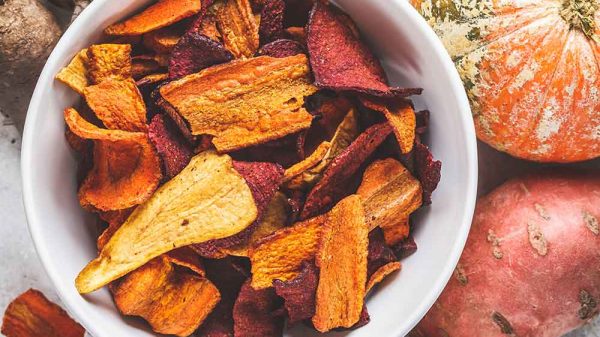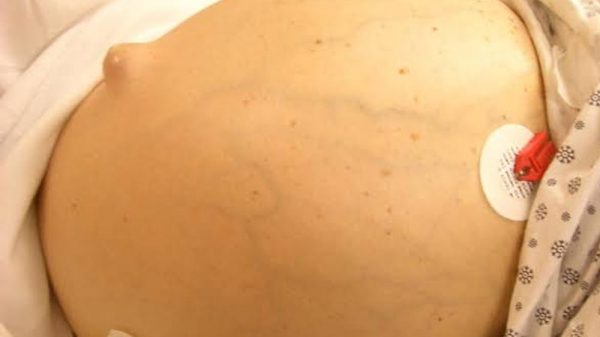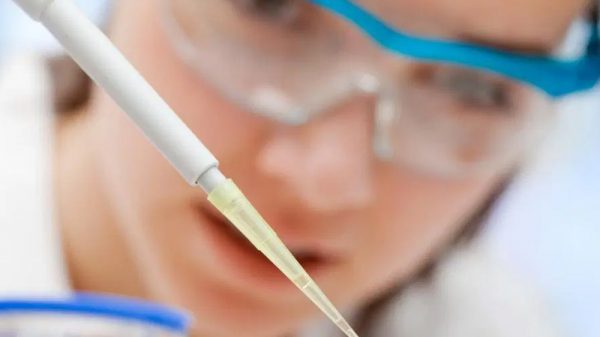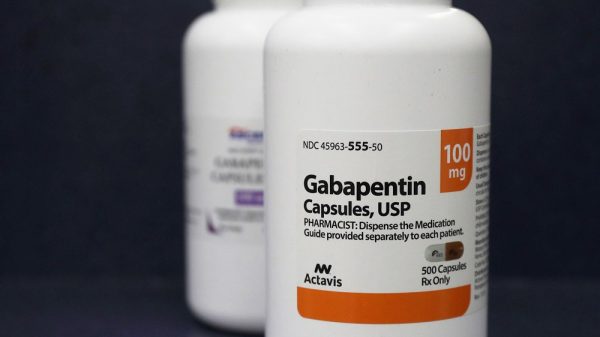Chronic kidney disease is a surprisingly common diagnosis. But that doesn’t make it any less scary. On top of that, there are five different stages of kidney disease. Stage 3 kidney disease signifies a moderate level of kidney damage and you may be wondering what your options are. If you’ve recently received this diagnosis, you may be asking: can stage 3 kidney disease be reversed?
What Does the Kidney Do?
You have two kidneys in your body that resemble the kidney beans commonly added to chili recipes. Your kidneys are located on either side of the abdomen and are responsible for filtering your blood, balancing the water content in your body, and maintaining a healthy pH (or acidity level). Hormones that impact blood pressure, sodium levels, potassium levels calcium absorption, and red blood cell production are all produced by the kidneys.
The kidneys are part of the renal system, which also includes the ureters, bladder, and urethra. After your kidneys filter your blood, excess water and waste are transferred through the ureters into the bladder and finally expelled through the urethra as urine.
Let’s take a closer look at the inside of a kidney. Hundreds of thousands – and sometimes more than a million – nephrons are housed within the kidney. The nephron acts as a tiny filter and can be further subdivided into the glomerulus and tubule. Glomeruli are blood vessels that separate fluid from solid compounds like proteins. The tubules return useful fluids and compounds to the bloodstream, and direct waste products out of the kidney for excretion.
When dealing with health issues involving the kidney, the doctors you commonly visit are nephrologists and urologists. Nephrology encompasses diseases and disorders that impact the kidney’s ability to carry out normal functions. Urology focuses more on structural disorders of the renal system, including the ureters, bladder, and urinary tract.
Stage 3 Kidney Disease Symptoms: What You May Be Experiencing
Early stages of kidney disease are often difficult to detect, and you may not experience any symptoms at all. The stages of kidney disease exist on a spectrum ranging from stage 1 to stage 5. While stage 1 indicates minimal kidney damage, stage 5 indicates end-stage kidney disease, loss of kidney function, and kidney failure. Chronic kidney disease stage 3 lies in the middle of the spectrum, and though kidney function will be compromised, you may or may not exhibit symptoms.
What Medical Tests Show: Indicators of Stage 3 Kidney Disease
If you have stage 3 chronic kidney disease (CKD), indicators of kidney dysfunction will raise red flags on your medical tests. The indicators include:
- Creatinine: As your body facilitates protein turnover when synthesizing new muscle tissue, producing creatinine as a waste product. Creatinine is also a byproduct of metabolizing meat. When the kidneys become inefficient due to chronic kidney disease, they are less able to filter out creatinine. As a result, creatinine will accumulate in the blood and show up as elevated in blood tests.
- Protein: The glomeruli in the nephrons are responsible for retaining proteins when filtering fluid in the body. Healthy kidneys inhibit the passage of proteins into the urine. If the kidney’s filtering mechanisms are compromised, these proteins make their way into the urine, causing high levels of protein to be detected in urine tests. High protein in the urine is called albuminuria or proteinuria.
- Estimated Glomerular Filtration Rate (eGFR, or GFR): This measurement is calculated using plasma creatinine levels and takes into account your age, sex, and race. The normal eGFR for a healthy adult is above 90 mL/min/1.73 m2.
- Blood Pressure: Because the kidney plays an important role in regulating blood pressure, a high blood pressure reading is an indicator that your kidneys aren’t functioning as well as they should.
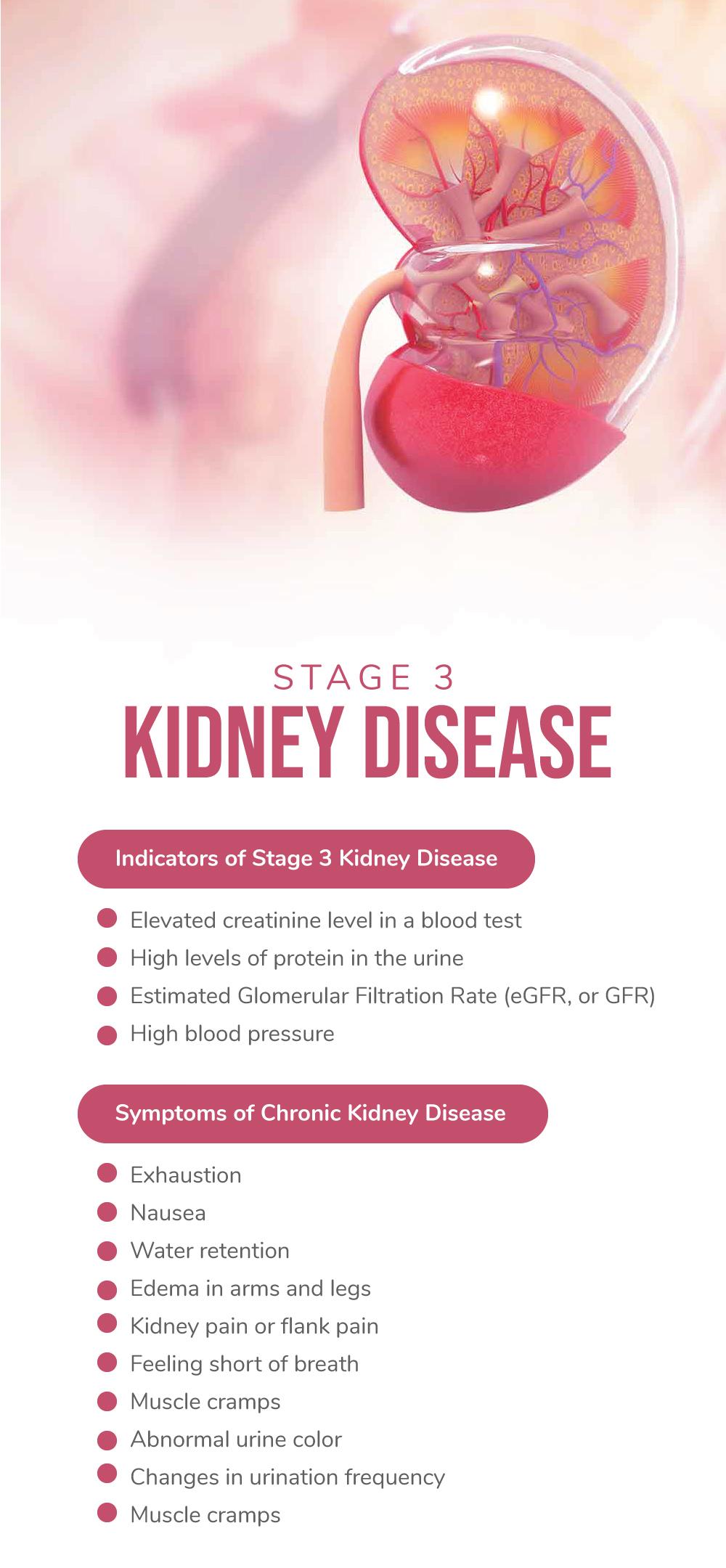
Symptoms of Chronic Kidney Disease
In some cases, stage 3 chronic kidney disease will not manifest in any noticeable physical symptoms. In other cases, stage 3 chronic kidney disease may cause symptoms including:
- Exhaustion
- Nausea
- Water retention
- Edema in arms and legs
- Kidney pain or flank pain
- Feeling short of breath
- Muscle cramps
- Abnormal urine color
- Changes in urination frequency
- Muscle cramps
Underlying Causes and Risk Factors for Kidney Disease
Kidney disease most commonly develops as a complication of other health conditions, especially metabolic syndrome, type 2 diabetes, hypertension, heart disease, and obesity. (1) A diet high in salt, sugar, saturated fat, and meat can put excessive stress on the kidneys that essentially leads to burnout.
High blood pressure exerts pressure on the vessels that carry blood through your kidneys, including the renal artery and glomeruli. Over time, chronic blood pressure can cause these vessels to scar and damage kidney tissues. High blood pressure and kidney disease are highly interrelated; hypertension can directly cause kidney disease, and declining kidney function exacerbates hypertension. This is because as function deteriorates, the kidney becomes less able to regulate sodium and potassium levels in the blood and is also unable to respond effectively to blood pressure changes by releasing hormones.
Other risk factors for developing chronic kidney disease include kidney stones, exposure to environmental toxins and pesticides, infections, and the genetic predisposition for developing kidney disease.
Potential Complications
If kidney function continues to deteriorate, stage 3 kidney disease can progress to stage 4 and stage 5. The later stages of kidney disease increase the risk of facing renal failure, which is managed with dialysis or a kidney transplant.
Luckily, stage 3 kidney disease can be managed, and there are actions you can take in your daily life to reduce the strain on your kidneys and prevent progression.
How to Reverse Kidney Disease Naturally
To reverse kidney damage and halt the progression of kidney disease, it is crucial to treat the underlying cause. Here we discuss the specific ways to reverse kidney disease related to the most common causes, including metabolic syndrome, diabetes, and hypertension.
In other cases of kidney disease, these suggestions may still be helpful. However, if the underlying cause of your diagnosis is related to infection, a genetic disorder like polycystic kidney disease, or exposure to toxins, then specialized treatment may be required. In any case, always work with your doctors and consult him or her regarding dietary guidelines for your case of kidney disease.
The Protein Debate: How Much and What Kind of Protein Is Best for Chronic Kidney Disease?
Historically, restricting protein intake has been a fundamental treatment guideline for chronic kidney disease. Lower protein intake means the kidneys don’t have to work as hard to filter out byproducts of protein metabolism. In turn, the kidney’s function is preserved and is less likely to become exhausted and deteriorate.
When It Comes to Kidney Function: Not All Protein Is Created Equal
Research shows that plant protein may be better for kidney function than animal protein by effectively lowering creatinine levels in the blood and protein in the urine. (2)
In a study published in the Kidney International Reports journal, a vegetarian diet seemed to exert protective effects on renal function, with lower rates of CKD found among diabetic patients who consumed more plant protein. (3)
Moreover, another study conducted by researchers at the University of Utah School of Medicine found that a higher ratio of plant protein consumption was associated with a lower mortality risk for patients with chronic kidney disease. (4)
Stick to Vegetable Protein Sources
Keep in mind that the sustained restriction of all dietary protein would invariably lead to muscle wasting and malnutrition. In turn, this would severely compromise your immune system and your body’s ability to repair tissue damage. Make sure you fuel your body with an adequate amount of protein from a variety of plant sources, including whole grains, nuts, seeds, and legumes.
Here are some excellent sources of plant protein to incorporate into the renal diet menu:
- Quinoa
- Brown rice
- Flaxseeds
- Chia seeds
- Oats
- Buckwheat
- Lentils
- Chickpeas
- Pumpkin seeds
- Walnuts
Just keep in mind that any one plant source will not provide all the essential amino acids needed to carry out all biological functions. Make sure to consume a variety of plant-based sources to meet essential amino acid requirements each day.
Additionally, supplementing with essential amino acids may be beneficial for maintaining muscle mass if you’re advised to restrict protein intake. Before taking supplements, make sure to check in with your doctor to ensure that supplements complement your regimen and work with your condition.
Eat Lots of Fruits and Vegetables
Fruits and vegetables are rich in antioxidants, vitamins, and other nutrients that facilitate the healthy functioning of all of your organs. Factors such as poor diet and environmental exposure to toxins can cause inflammation and oxidative stress. When your organs experience oxidative stress, waste products and free radicals build up in cells. As a result, your cells’ operations are sluggish and carry out functions less efficiently, which can exacerbate conditions like chronic kidney disease.
Antioxidant compounds such as polyphenols protect renal function by lowering inflammation and reducing oxidative stress. Vitamin C is another antioxidant naturally found in fruits and vegetables that may have implications for reversing chronic kidney disease. A study published in the Clinical Kidney Journal revealed that vitamin C may reduce oxidative stress and improve blood pressure for individuals with chronic kidney disease. (5)
Here are fruits and veggies you can add to your renal diet menu:
- Broccoli
- Kale
- Cauliflower
- Papaya
- Avocado
- Blueberries
- Raspberries
- Strawberries
- Cherries
- Sweet potatoes
Cut Out Processed Foods
Processed foods generally refer to anything that is sold in a package, such as cookies, crackers, chips, processed meats, cheese, desserts, candy, and baked goods. Refined grains like white bread and white pasta are also categorized as processed foods.
Manufactured food items can have deleterious effects on kidney function. Added preservatives to retain freshness are artificial chemicals that can be taxing for your kidney to process. The high salt content of preserved meats and cheeses contributes to high blood pressure and makes it more difficult for your kidney to control blood sodium levels and water retention. Moreover, processed foods high in refined sugar like soft drinks and candies spikes your blood sugar, which can over time lead to insulin resistance, diabetes, and chronic kidney disease.
Additionally, processed foods are usually high in calories, low in essential nutrients, and lack the compounds that improve renal function.
Get Enough Vitamin D
Research shows that vitamin D exerts protective effects on the kidney and its function by inhibiting the development of renal scar tissue and lowering inflammation. (6) Fatty fish and egg yolks are good sources of vitamin D, but generally, animal proteins are not beneficial for chronic kidney disease. Because your skin synthesizes vitamin D, try getting most of your vitamin D from 15 minutes of sun exposure. In some cases, vitamin D supplementation may be a good idea but always check with your doctor first.
Maintain a Healthy Weight
Having a high body mass index is a risk factor for chronic kidney disease and losing weight may help improve kidney function. Regular exercise helps you burn more calories. Introducing a workout plan into your daily routine can also help improve both your kidney function and cardiovascular health by lowering blood pressure.
In addition to exercise, stick to whole plant-based foods that are high in fiber, including whole grains, fruits, vegetables, beans, nuts, and seeds.
The steps to achieve a healthy weight will simultaneously improve metabolic conditions like insulin resistance and type 2 diabetes, as well as associated conditions like fatty liver disease and chronic kidney disease.
Stage 3 Kidney Disease Life Expectancy
Several factors influence the prognosis of chronic kidney disease. Research shows that a lower eGFR is connected to a shorter life expectancy. (7) Additionally, worsening proteinuria tends to be a better predictor of deteriorating kidney health than serum creatinine. Age is also a factor that influences life expectancies with chronic kidney disease, with older adults being at a higher risk of progressive kidney disease than younger adults. (7)
However, diet and lifestyle play a large role in kidney health. Adopting a kidney-friendly diet and lifestyle changes will have a positive influence on your kidney function and prognosis, and may increase your life expectancy.
Key Takeaways for Reversing Stage 3 Kidney Disease
- Stick to plant protein, and limit or eliminate animal protein
- Eat lots of fruits and vegetables
- Exercise and maintain a healthy weight
Conclusion
The bottom line is that stage 3 chronic kidney disease doesn’t have to progress. The human body is a remarkable, self-repairing, biological machine, and there are things you can do at home to help your kidneys heal so that you can maintain a high quality of life.

References:
(1) https://www.ncbi.nlm.nih.gov/pmc/articles/PMC6341126/
(2) https://www.jrnjournal.org/article/S1051-2276(17)30102-4/pdf
(3) https://www.ncbi.nlm.nih.gov/pmc/articles/PMC6506707/
(4) https://www.ncbi.nlm.nih.gov/pmc/articles/PMC4769135/
(5) https://academic.oup.com/ckj/article/11/4/530/5045638
